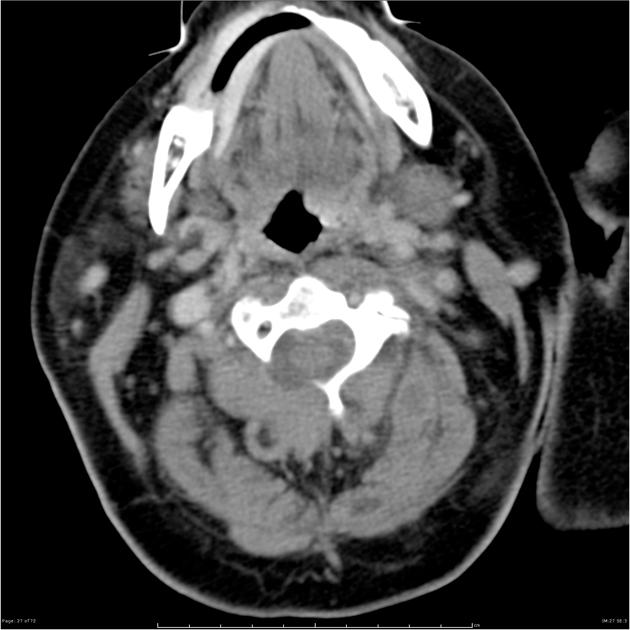Epidural abscess CT: Difference between revisions
Joao Silva (talk | contribs) |
m (Bot: Removing from Primary care) |
||
| (31 intermediate revisions by 4 users not shown) | |||
| Line 1: | Line 1: | ||
__NOTOC__ | __NOTOC__ | ||
{{Epidural abscess}} | {{Epidural abscess}} | ||
{{CMG}} | {{CMG}} {{AE}} {{JS}}; {{AG}} | ||
==Overview== | ==Overview== | ||
Computed tomography may be helpful as a secondary method of imaging in the diagnosis of epidural abscess. If [[MRI]] is not available, [[CT scan]] may serve as the primary imaging technique. | |||
==Computed tomography== | |||
Computed tomography may be helpful as a secondary method of imaging in the diagnosis of epidural abscess. If [[MRI]] is not available, [[CT scan]] may serve as the primary imaging technique. | |||
===Intracranial Epidural Abscess=== | ===Intracranial Epidural Abscess=== | ||
Findings on CT scan suggestive of intracranial epidural abscess include the appearance of a crescent-shaped, hypodense, extraaxial lesion or a lens.<ref>{{Cite book | last1 = Longo | first1 = Dan L. (Dan Louis) | title = Harrison's principles of internal medici | date = 2012 | publisher = McGraw-Hill | location = New York | isbn = 978-0-07-174889-6 | pages = }}</ref> | |||
===Spinal Epidural Abscess=== | ===Spinal Epidural Abscess=== | ||
On CT scan, the appearance of a spinal epidural abscess is difficult to discern. Findings on CT scan suggestive of spinal epidural abscess include narrowing of the disk and bone [[lysis]] to indicate the presence of [[discitis]] and [[osteomyelitis]].<ref name="pmid17093252">{{cite journal |vauthors=Darouiche RO |title=Spinal epidural abscess |journal=The New England Journal of Medicine |volume=355 |issue=19 |pages=2012–20 |year=2006 |pmid=17093252 |doi=10.1056/NEJMra055111 |url=}}</ref><ref name=RadioSEA> Spinal Epidural Abscess. Radiopaedia.org (2015). http://radiopaedia.org/articles/spinal-epidural-abscess Accessed on November 20, 2015</ref> While helpful to produce high-resolution axial tomograms of the [[spine]], being able to detect a possible encroachment of the [[spinal canal]] or air in the [[pus]] collection is difficult due to CT scan's insufficient capacity to differentiate densities of soft tissues.<ref name="Grewal2006">{{cite journal|last1=Grewal|first1=S.|title=Epidural abscesses|journal=British Journal of Anaesthesia|volume=96|issue=3|year=2006|pages=292–302|issn=0007-0912|doi=10.1093/bja/ael006}}</ref> It may be used to guide [[percutaneous]] drainage, alternatively to [[surgical]] drainage.<ref name="pmid12182793">{{cite journal| author=Lyu RK, Chen CJ, Tang LM, Chen ST| title=Spinal epidural abscess successfully treated with percutaneous, computed tomography-guided, needle aspiration and parenteral antibiotic therapy: case report and review of the literature. | journal=Neurosurgery | year= 2002 | volume= 51 | issue= 2 | pages= 509-12; discussion 512 | pmid=12182793 | doi= | pmc= | url=http://www.ncbi.nlm.nih.gov/entrez/eutils/elink.fcgi?dbfrom=pubmed&tool=sumsearch.org/cite&retmode=ref&cmd=prlinks&id=12182793 }}</ref> More information regarding the appearance of spinal epidural abscess can be found [http://eradiology.bidmc.harvard.edu/LearningLab/central/Tukey.pdf here]. | |||
[[Image:Epidural abscess at the level of C2-C3 anterolaterally.jpg|left|200px||thumb|Spinal epidural abscess located anterolaterally at the level of C2-C3<ref name=SEACTScan> Image courtesy of Royal Melborne Hospital Key Conditions. [http://www.radiopaedia.org Radiopaedia] (original file [http://radiopaedia.org/cases/epidural-and-paraspinal-abscesses "here"]). [http://radiopaedia.org/licence Creative Commons BY-SA-NC]</ref>]] | |||
<br><br><br><br><br><br><br><br><br><br><br><br><br> | |||
==References== | ==References== | ||
{{Reflist|2}} | {{Reflist|2}} | ||
[[Category:Disease]] | [[Category:Disease]] | ||
[[Category:Neurology]] | [[Category:Neurology]] | ||
Latest revision as of 21:36, 29 July 2020
|
Epidural abscess Microchapters |
|
Diagnosis |
|---|
|
Treatment |
|
Case Studies |
|
Epidural abscess CT On the Web |
|
American Roentgen Ray Society Images of Epidural abscess CT |
Editor-In-Chief: C. Michael Gibson, M.S., M.D. [1] Associate Editor(s)-in-Chief: João André Alves Silva, M.D. [2]; Anthony Gallo, B.S. [3]
Overview
Computed tomography may be helpful as a secondary method of imaging in the diagnosis of epidural abscess. If MRI is not available, CT scan may serve as the primary imaging technique.
Computed tomography
Computed tomography may be helpful as a secondary method of imaging in the diagnosis of epidural abscess. If MRI is not available, CT scan may serve as the primary imaging technique.
Intracranial Epidural Abscess
Findings on CT scan suggestive of intracranial epidural abscess include the appearance of a crescent-shaped, hypodense, extraaxial lesion or a lens.[1]
Spinal Epidural Abscess
On CT scan, the appearance of a spinal epidural abscess is difficult to discern. Findings on CT scan suggestive of spinal epidural abscess include narrowing of the disk and bone lysis to indicate the presence of discitis and osteomyelitis.[2][3] While helpful to produce high-resolution axial tomograms of the spine, being able to detect a possible encroachment of the spinal canal or air in the pus collection is difficult due to CT scan's insufficient capacity to differentiate densities of soft tissues.[4] It may be used to guide percutaneous drainage, alternatively to surgical drainage.[5] More information regarding the appearance of spinal epidural abscess can be found here.

References
- ↑ Longo, Dan L. (Dan Louis) (2012). Harrison's principles of internal medici. New York: McGraw-Hill. ISBN 978-0-07-174889-6.
- ↑ Darouiche RO (2006). "Spinal epidural abscess". The New England Journal of Medicine. 355 (19): 2012–20. doi:10.1056/NEJMra055111. PMID 17093252.
- ↑ Spinal Epidural Abscess. Radiopaedia.org (2015). http://radiopaedia.org/articles/spinal-epidural-abscess Accessed on November 20, 2015
- ↑ Grewal, S. (2006). "Epidural abscesses". British Journal of Anaesthesia. 96 (3): 292–302. doi:10.1093/bja/ael006. ISSN 0007-0912.
- ↑ Lyu RK, Chen CJ, Tang LM, Chen ST (2002). "Spinal epidural abscess successfully treated with percutaneous, computed tomography-guided, needle aspiration and parenteral antibiotic therapy: case report and review of the literature". Neurosurgery. 51 (2): 509–12, discussion 512. PMID 12182793.
- ↑ Image courtesy of Royal Melborne Hospital Key Conditions. Radiopaedia (original file "here"). Creative Commons BY-SA-NC